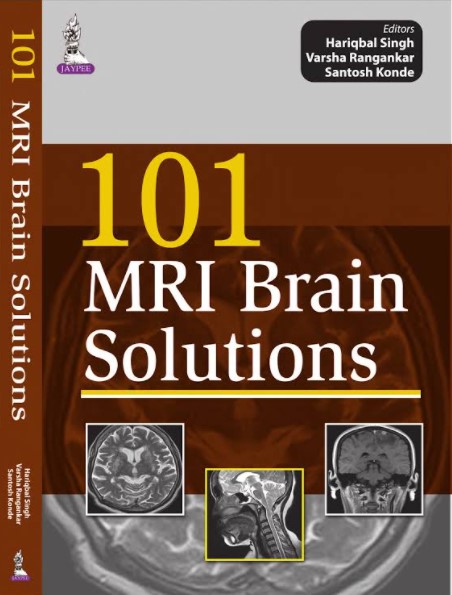Indexing & Abstracting
Full Text
OpinionDOI Number : 10.36811/ojrmi.2021.110016Article Views : 30Article Downloads : 18
101 MRI Brain Solutions, 1st Edition: A Book Review
Abdulwahab Alahmari
Radiology Specialist, Radiology Department, Al-Namas General Hospital, Ministry of Health, Al- Namas City, Saudi Arabia
*Corresponding Author: Abdulwahab Alahmari, Radiology Specialist, Radiology Department, Al- Namas General Hospital, Ministry of Health, Al-Namas City, Saudi Arabia, Tel: +966562428716; Email: afaa99@hotmail.co.uk
ORCID ID: 0000-0002-9959-830X
Article Information
Aritcle Type: Opinion
Citation: Abdulwahab Alahmari, et al. 2021. 101 MRI Brain Solutions, 1st Edition: A Book Review. O J Radio Med Img. 4: 49-50.
Copyright: This is an open-access article distributed under the terms of the Creative Commons Attribution License, which permits unrestricted use, distribution, and reproduction in any medium, provided the original author and source are credited. Copyright © 2021; Abdulwahab Alahmari
Publication history:
Received date: 13 September, 2021Accepted date: 20 September, 2021
Published date: 22 September, 2021
This book is written by a group of Neuroradiologists from an Indian university and published by Jaypee Brothers Medical Publishers (P) Ltd see (Figure 1). The first chapter discusses the physical principles of MRI and the 2nd chapter illustrates brain anatomy. From the 3rd to 11th chapter, all chapters discuss different malformations and disorders that affect the brain. Chapters 12th and 13th are glossary and acronyms respectively. The only colored pictures are in the plate and the rest of the book illustrations has no colors. Each chapter is written by a Neuroradiologists of the 14 authors of the book (3 editors and 11 contributors). The used method in 3rd to 11th chapter is a presentation of a case as an example of the brain malformation or disorder on an MRI scan. The book uses Radioland’s style in presenting the cases. Each case will have a case presentation and history, MRI scan pictures, MRI findings, comments and explanations, opinions, and clinical discussion. This book is (101), so it is for beginners and it does not cover all MRI neuroradiology topics since it has 101 cases only. The book has too many English language mistakes and a significant lack of proofreading. Some of the MRI images have poor image quality. The book is printed on high-quality papers. In some chapters of the book, there are some CT scans to show the difference between MRI and CT in the ability to show some of the abnormalities. The medical illustration is not high-quality illustration; for example; the Percheron artery was illustrated in the book poorly. Nobody should expect to see professional illustrations like Netter’s style in illustrations in this book. In the book, they rarely use arrows to indicate the location of the pathology. The book does not mention some of the famous neuroradiology signs. In the subdural hematoma case, they present a case of acute on chronic hematoma as subdural hematoma case which would be better to show acute in one case, chronic in one case, and acute on chronic on a third case because this book is for beginners. Some anatomical illustrations are out of the chapter which discuss the anatomy of the brain like the illustration of the cerebral venous system on page 137, figure 28. From page 139 to 144, the book presents three anatomical variations in the brain’s vasculatures (carotid cavernous fistula, persistent occipital sinus, and fetal posterior cerebellar artery) which would be better to be in a separate chapter about anatomical variations. Sometimes, the book will mention a famous neuroradiology sign without providing any MRI image as a demonstration. As well, the book will describe some findings which is invisible on MRI images and the authors will write “not seen in these images”. If the finding is not demonstrated for the readers, the authors should not mention it in the findings. Instead, they can include this undemonstrated finding in the comments and explanation section of the case. This book will mention too many things (radiological signs, findings, associated conditions, etc.) without showing figures for what they are writing about like in the astrocytoma case they mention astrocytoma’s types without differentiating them on figures. Plus, the cases are not mentioned in an organized fashion. For example, the book will speak about a tumor that affects a specific region (let’s call it region number 1) then they will write about another tumor in a different region (let’s call it region number 2) then they jump back to the first region and write about another tumor that affects region number 1. The book needs to be organized to write; for example; the tumors in cerebellopontine angle together which will help the reader to collect and compare all the information about the tumors that affect this region then move to another region. The book will provide a low image quality with too many artifacts; for example; the diffusion image in the hypoglycemia case. The artifacts chapter discusses only three common types of artifacts which are the Gibbs phenomenon, zipper artifact, and susceptibility artifact. The chapter can be improved by organizing the artifacts like; patient-related, signal processing related, and machinery (hardware) related artifacts. The artifacts’ chapter is placed in between clinical cases which should be removed to the beginning or at the end of the book. The last chapter collected different cases under miscellaneous.
Most of the cases in the book, have seizures as clinical presentation and the sentence looks the same in most of the cases which looks like a copy past sentence in the presentation (at the beginning) of many cases. It will be better to write more about the patient’s history. The book uses American English in some chapters and British English in others; for example; they use, and “and” at the end of the sentence in both American and British English style which looks like a lack of editing. Generally, the book is a very good source for beginners in neuroradiology, but it needs an extensive English language editing to keep one style and avoid grammatical mistakes.





















